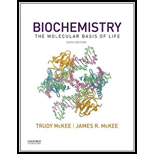
To review:
Definition of the following biological terminologies:
a. Biomolecule
b. Macromolecule
c. Enzyme
d.
e. Homeostasis
Introduction:
A living organism is able to sustain and regulate its biological functions due to variety and diversity of
Explanation of Solution
Following are the definitions for the biological terminologies:
a. Biomolecule:
These are the molecules found in the living organisms and are vital for the functioning, growth, development, and regulation of the living system. These contain macromolecules like proteins, carbohydrates, fats (lipids) and nucleic acids. Biomolecules consist of inorganic and organic components: inorganic component consist of water, ions like (Na+), potassium (K+), magnesium (Mg2+), and calcium (Ca2+), and organic component consist carbon, hydrogen, oxygen, nitrogen, phosphorus, and sulfur.
b. Macromolecule:
These are large molecules as they are comprised of thousands of atoms which makes them a complete molecule. For example, in a biological system proteins and nucleic acids are macromolecules.
c. Enzyme:
Enzyme is defined as a biological catalyst (protein molecules) enhances the rate of a
d. Metabolism:
In order to regulate and maintain life, there are various reactions which undergo within a living system. This involves the synthesis of new compounds and breakdown of other molecules. All these reactions occur within the body and are referred to as a metabolic reaction and phenomenon is called metabolism.
e. Homeostasis:
A physiological process in which equilibrium condition is maintained or constant internal environment is maintained within a living organism.
Biomolecules, macromolecules, enzymes are the biological molecules while metabolism and homeostasis are the biological processes essential to maintain the integrity and efficiency of biological system.
Want to see more full solutions like this?
Chapter 1 Solutions
Biochemistry, The Molecular Basis of Life, 6th Edition
- What is the formation of glycosylated hemoglobin (the basis for the HbA1c test)? Can you describe it?arrow_forwardPlease analze the gel electrophoresis column of the VRK1 kinase (MW: 39.71 kDa). Also use a ruler to measure the length of the column in centimeters and calculate the MW of each band observed. Lane 1: buffer Lane 2 : Ladder Lane 3: Lysate Lane 4: Flowthrough Lane 5: Wash Lanes 6-8: E1, E2, E3 Lane 9: Dialyzed VRK1 Lane 10: LDHarrow_forwardDo sensory neurons express ACE2 or only neurolipin-1 receptors for COVID19 virus particle binding?arrow_forward
- Explain the process of CNS infiltration of COVID19 through sensory neurons from beginning to end, including processes like endocytosis, the different receptors/proteins that are involved, how they are transported and released, etc.,arrow_forwardH2C CH2 HC-COOO CH2 ܘHO-C-13c-O isocitrate C-S-COA H213c CH2 C-OO 13C-S-COA CH2 C-00 the label will not be present in succinyl CoA C-S-COA succinyl-CoAarrow_forwardA culture of kidneys cells contains all intermediates of the citric acid cycle. It is treated with an irreversible inhibitor of malate dehydrogenase, and then infused withglucose. Fill in the following list to account for the number of energy molecules that are formed from that one molecule of glucose in this situation. (NTP = nucleotidetriphosphate, e.g., ATP or GTP)Net number of NTP:Net number of NADH:Net number of FADH2:arrow_forward
- 16. Which one of the compounds below is the final product of the reaction sequence shown here? OH A B NaOH Zn/Hg aldol condensation heat aq. HCI acetone C 0 D Earrow_forward2. Which one of the following alkenes undergoes the least exothermic hydrogenation upon treatment with H₂/Pd? A B C D Earrow_forward6. What is the IUPAC name of the following compound? A) (Z)-3,5,6-trimethyl-3,5-heptadiene B) (E)-2,3,5-trimethyl-1,4-heptadiene C) (E)-5-ethyl-2,3-dimethyl-1,5-hexadiene D) (Z)-5-ethyl-2,3-dimethyl-1,5-hexadiene E) (Z)-2,3,5-trimethyl-1,4-heptadienearrow_forward
- Consider the reaction shown. CH2OH Ex. CH2 -OH CH2- Dihydroxyacetone phosphate glyceraldehyde 3-phosphate The standard free-energy change (AG) for this reaction is 7.53 kJ mol-¹. Calculate the free-energy change (AG) for this reaction at 298 K when [dihydroxyacetone phosphate] = 0.100 M and [glyceraldehyde 3-phosphate] = 0.00300 M. AG= kJ mol-1arrow_forwardIf the pH of gastric juice is 1.6, what is the amount of energy (AG) required for the transport of hydrogen ions from a cell (internal pH of 7.4) into the stomach lumen? Assume that the membrane potential across this membrane is -70.0 mV and the temperature is 37 °C. AG= kJ mol-1arrow_forwardConsider the fatty acid structure shown. Which of the designations are accurate for this fatty acid? 17:2 (48.11) 18:2(A9.12) cis, cis-A8, A¹¹-octadecadienoate w-6 fatty acid 18:2(A6,9)arrow_forward
 Principles Of Radiographic Imaging: An Art And A ...Health & NutritionISBN:9781337711067Author:Richard R. Carlton, Arlene M. Adler, Vesna BalacPublisher:Cengage Learning
Principles Of Radiographic Imaging: An Art And A ...Health & NutritionISBN:9781337711067Author:Richard R. Carlton, Arlene M. Adler, Vesna BalacPublisher:Cengage Learning- Essentials of Pharmacology for Health ProfessionsNursingISBN:9781305441620Author:WOODROWPublisher:Cengage





